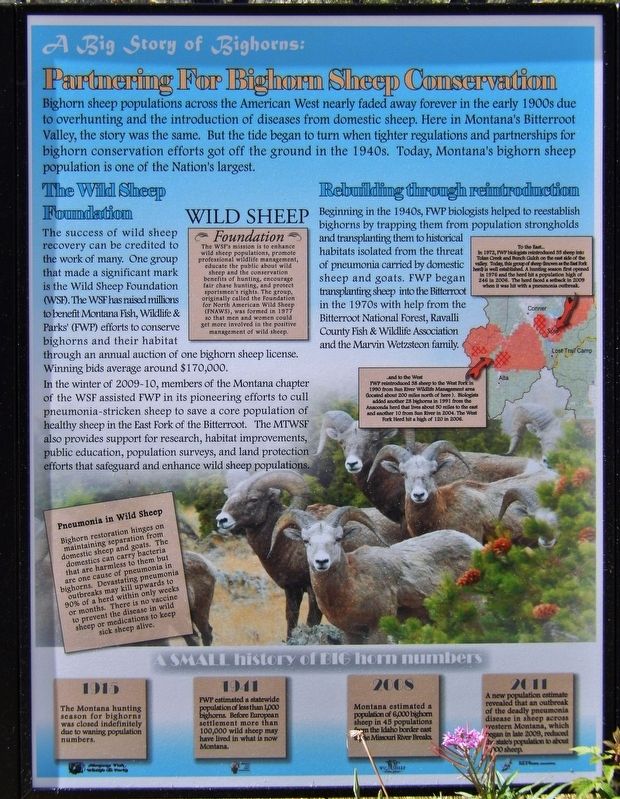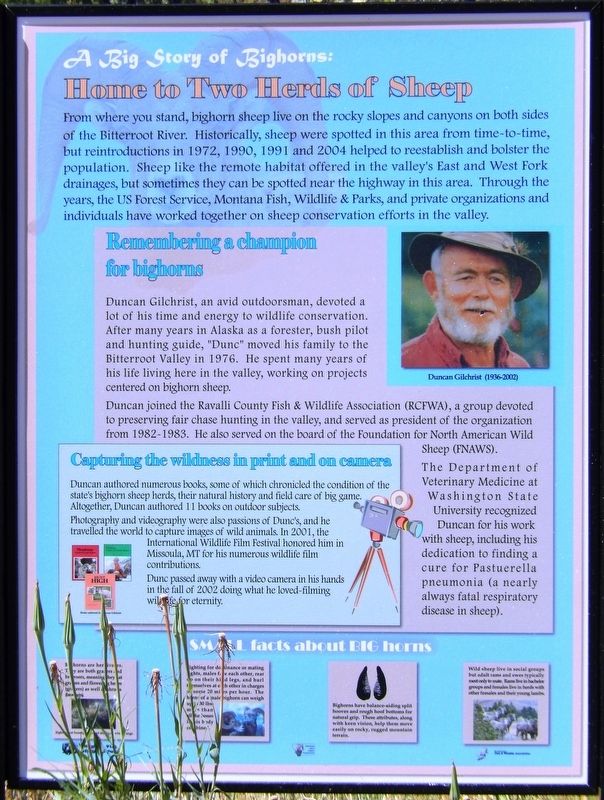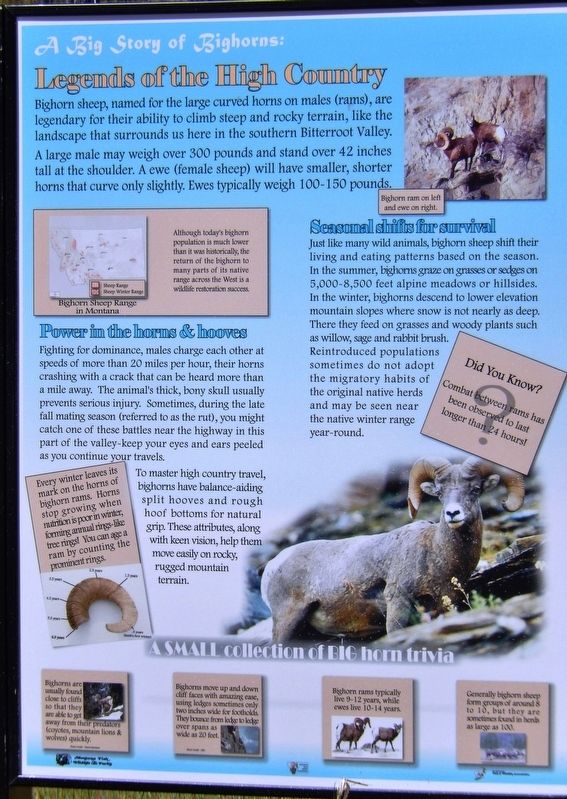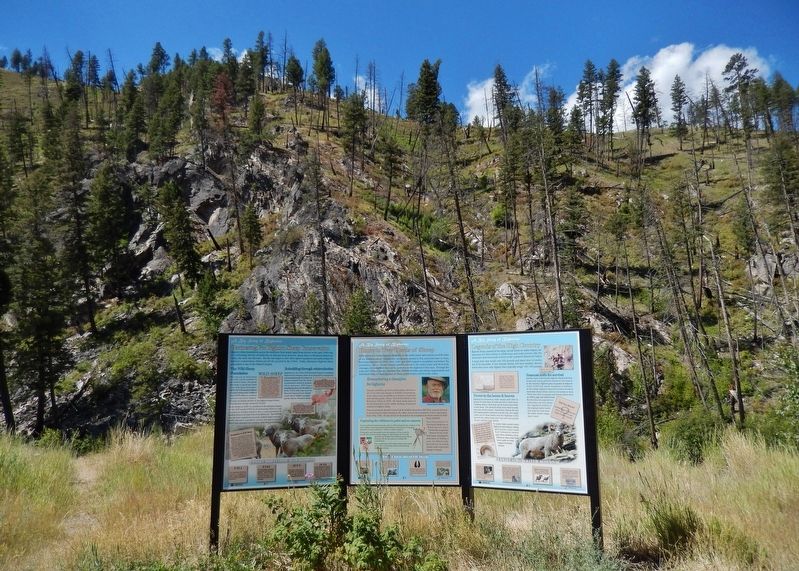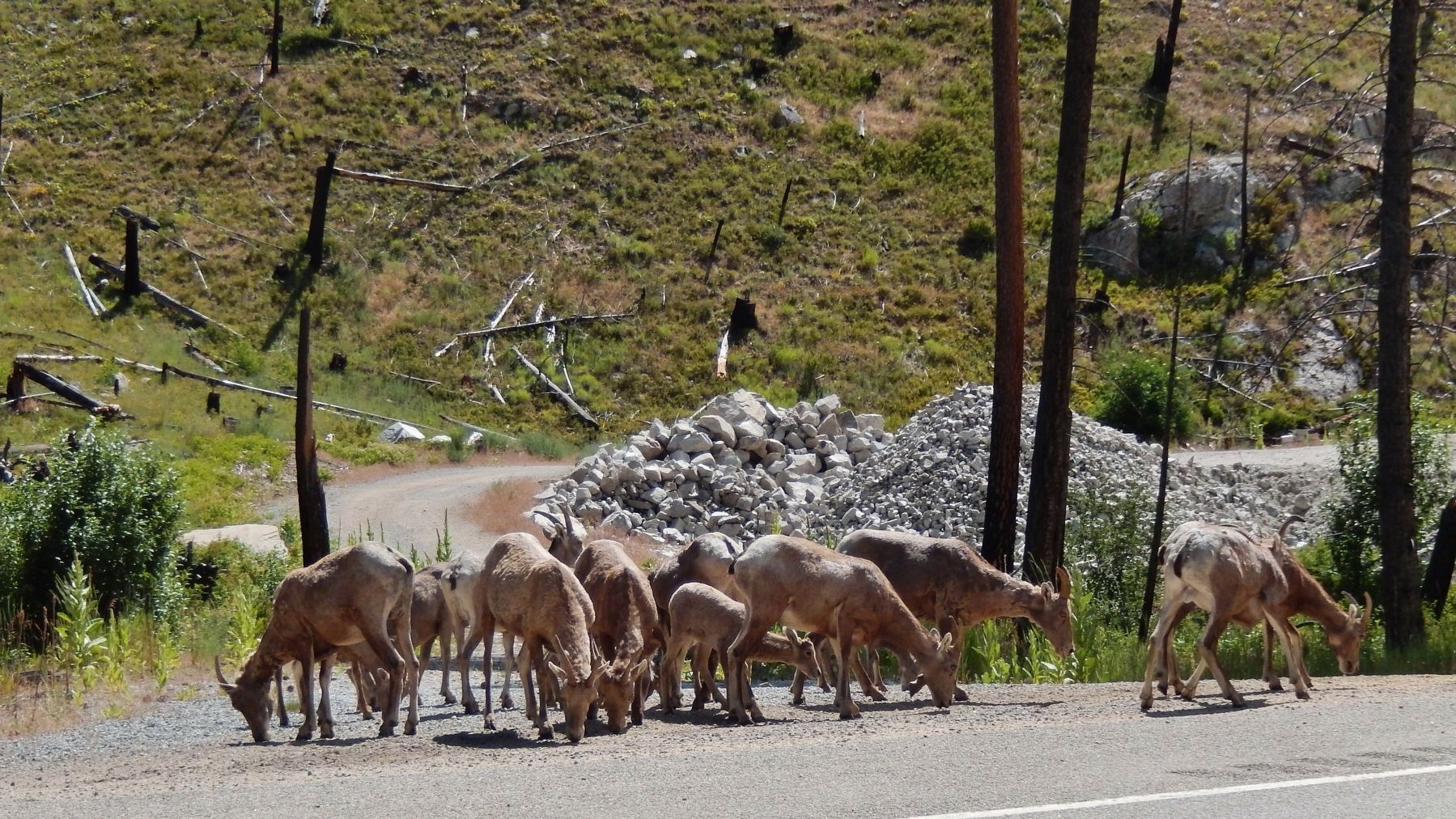Near Sula in Ravalli County, Montana — The American West (Mountains)
Big Horn Sheep Conservation
Inscription.
Partnering For Bighorn Sheep Conservation (panel 1)
Bighorn sheep populations across the American West nearly faded away forever in the early 1900s due to overhunting and the introduction of diseases from domestic sheep. Here in Montana’s Bitterroot Valley, the story was the same. But the tide began to turn when tighter regulations and partnerships for bighorn conservation efforts got off the ground in the 1940s. Today, Montana's bighorn sheep population is one of the Nation's largest.
The Wild Sheep Foundation
The success of wild sheep recovery can be credited to the work of many. One group that made a significant mark is the Wild Sheep Foundation (WSF). The WSF has raised millions to benefit Montana Fish, Wildlife & Parks' (FWP) efforts to conserve bighorns and their habitat through an annual auction of one bighorn sheep license. Winning bids average around $170,000.
In the winter of 2009-10, members of the Montana chapter of the WSF assisted FWP in its pioneering efforts to cull pneumonia-stricken sheep to save a core population of healthy sheep in the East Fork of the Bitterroot. The MTWSF also provides support for research, habitat improvements, public education, population surveys, and land protection efforts that safeguard and enhance wild sheep populations.
The WSF's mission is to enhance wild sheep populations, promote professional wildlife management, educate the public about wild sheep and the conservation benefits of hunting, encourage fair chase hunting, and protect sportsmen's rights. The group, originally called the Foundation for North American Wild Sheep (FNAWS), was formed in 1977 so that men and women could get more involved in the positive management of wild sheep.
Rebuilding through Reintroduction
Beginning in the 1940s, FWP biologists helped to reestablish bighorns by trapping them from population strongholds and transplanting them to historical habitats isolated from the threat of pneumonia carried by domestic sheep and goats. FWP began transplanting sheep into the Bitterroot in the 1970s with help from the Bitterroot National Forest, Ravalli County Fish & Wildlife Association and the Marvin Wetzsteon family.
To the East…
In 1972, FWP biologists reintroduced 35 sheep into Tolan Creek and Bunch Gulch on the east side of the valley. Today, this group of sheep (known as the East Fork herd) is well established. A hunting season first opened in 1976 and the herd hit a population high of 246 in 2006. The herd faced a setback in 2009 when it was hit with a pneumonia outbreak.
…and to the West
FWP reintroduced 38 sheep to the West Fork in 1990 from Sun River Wildlife Management area (located about 200 miles north of here). Biologists added another 28 bighorns in 1991 from the Anaconda herd that lives about 50 miles to the east and another 10 from Sun River in 2004. The West Fork Herd hit a high of 120 in 2006.
Pneumonia in Wild Sheep
Bighorn restoration hinges on Bighorn maintaining separation from domestic sheep and goats. The domestics can carry bacteria that are harmless to them but are one cause of pneumonia in bighorns. Devastating pneumonia outbreaks may kill upwards to 90% of a herd within only weeks or months. There is no vaccine to prevent the disease in wild sheep or medications to keep sick sheep alive.
1915 • The Montana hunting season for bighorns was closed indefinitely due to waning population numbers.
1941 • FWP estimated a statewide population of less than 1,000 bighorns. Before European settlement more than 100,000 wild sheep may have lived in what is now Montana.
2008 • Montana estimated a population of 6,000 bighorn sheep in 45 populations from the Idaho border east to the Missouri River Breaks
2011 • A new population estimate revealed that an outbreak of the deadly pneumonia disease in sheep across western Montana, which began in late 2009, reduced the state’s population to about 5,000 sheep.
Home to Two Herds of Sheep (panel 2)
From where you stand, bighorn sheep live on the rocky slopes and canyons on both sides of the Bitterroot River. Historically, sheep were spotted in this area from time-to-time, but reintroductions in 1972, 1990, 1991 and 2004 helped to reestablish and bolster the population. Sheep like the remote habitat offered in the valley's East and West Fork drainages, but sometimes they can be spotted near the highway in this area. Through the years, the US Forest Service, Montana Fish, Wildlife & Parks, and private organizations and individuals have worked together on sheep conservation efforts in the valley.
Remembering a Champion for Bighorns
Duncan Gilchrist, an avid outdoorsman, devoted a lot of his time and energy to wildlife conservation. After many years in Alaska as a forester, bush pilot and hunting guide, “Dunc” moved his family to the Bitterroot Valley in 1976. He spent many years of his life living here in the valley, working on projects centered on bighorn sheep.
Duncan joined the Ravalli County Fish & Wildlife Association (RCFWA), a group devoted to preserving fair chase hunting in the valley, and served as president of the organization from 1982-1983. He also served on the board of the Foundation for North American Wild Sheep (FNAWS).
The Department of Veterinary Medicine at Washington State University recognized Duncan for his work with
sheep, including his dedication to finding a cure for Pastuerella pneumonia (a nearly always fatal respiratory disease in sheep).
Capturing the Wilderness in Print and on Camera
Duncan authored numerous books, some of which chronicled the condition of the state’s bighorn sheep herds, their natural history and field care of big game. Altogether, Duncan authored 11 books on outdoor subjects.
Photography and videography were also passions of Dunc's, and he traveled the world to capture images of wild animals. In 2001, the International Wildlife Film Festival honored him in Missoula, MT for his numerous wildlife film contributions.
Dunc passed away with a video camera in his hands in the fall of 2002 doing what he loved - filming wildlife for eternity.
Legends of the High Country (panel 3)
Bighorn sheep, named for the large curved horns on males (rams), are legendary for their ability to climb steep and rocky terrain, like the landscape that surrounds us here in the southern Bitterroot Valley. A large male may weigh over 300 pounds and stand over 42 inches tall at the shoulder. A ewe (female sheep) will have smaller, shorter horns that curve only slightly. Ewes typically weigh 100-150 pounds.
Although today's bighorn population is much lower than it was historically, the return of the bighorn to many parts of its native
range across the West is a wildlife restoration success.
Power in the Horns & Hooves
Fighting for dominance, males charge each other at speeds of more than 20 miles per hour, their horns crashing with a crack that can be heard more than a mile away. The animal’s thick, bony skull usually prevents serious injury. Sometimes, during the late fall mating season (referred to as the rut), you might catch one of these battles near the highway in this part of the valley - keep your eyes and ears peeled as you continue your travels.
To master high country travel, bighorns have balance-aiding split hooves and rough hoof bottoms for natural grip. These attributes, along with keen vision, help them move easily on rocky, rugged mountain terrain.
Every winter leaves its mark on the horns of bighorn rams. Horns stop growing when nutrition is poor in winter; forming annual rings – like tree rings! You can age a ram by counting, the prominent rings.
Seasonal Shifts for Survival
Just like many wild animals, bighorn sheep shift their living and eating patterns based on the season. In the summer, bighorns graze on grasses or sedges on 5,000-8,500 feet alpine meadows or hillsides. In the winter, bighorns descend to lower elevation mountain slopes where snow is not nearly as deep. There they feed on grasses and woody plants such as willow, sage and rabbit brush. Reintroduced populations sometimes do not adopt the migratory habits of the original native herds and may be seen near the native winter range year-round.
Topics. This historical marker is listed in these topic lists: Animals • Environment • Parks & Recreational Areas • Science & Medicine.
Location. 45° 51.267′ N, 114° 1.186′ W. Marker is near Sula, Montana, in Ravalli County. Marker is on U.S. 93 south of Sula Peak Road, on the right when traveling south. Marker is located in a large pull-out and parking area on the west side of the highway overlooking the Bitterroot River. Touch for map. Marker is in this post office area: Sula MT 59871, United States of America. Touch for directions.
Other nearby markers. At least 8 other markers are within 11 miles of this marker, measured as the crow flies. Lewis and Clark at Ross' Hole (approx. 2.3 miles away); Ross' Hole (approx. 2.3 miles away); First Impressions (approx. 2.3 miles away); Survival (approx. 2.3 miles away); Mountains on the Move (approx. 2.3 miles away); The Great Clearing (approx. 2.3 miles away); Join the Voyage of Discovery (approx. 2.3 miles away); Trapper Peak (approx. 11.1 miles away). Touch for a list and map of all markers in Sula.
More about this marker. Marker consists of three large framed composite panels mounted side-by-side in an interpretive kiosk.
Credits. This page was last revised on January 12, 2019. It was originally submitted on January 9, 2019, by Cosmos Mariner of Cape Canaveral, Florida. This page has been viewed 303 times since then and 27 times this year. Photos: 1, 2, 3, 4, 5. submitted on January 9, 2019, by Cosmos Mariner of Cape Canaveral, Florida. • Andrew Ruppenstein was the editor who published this page.
